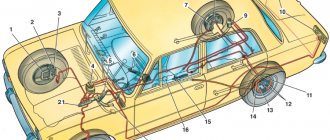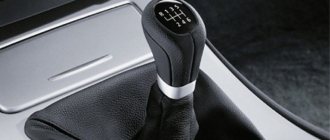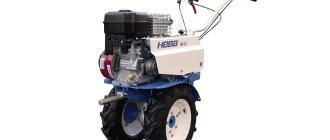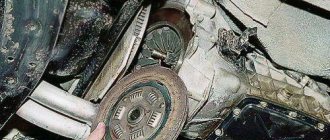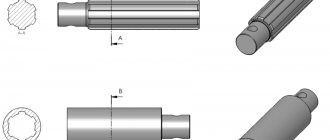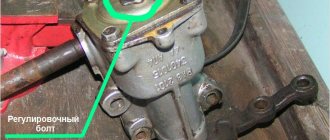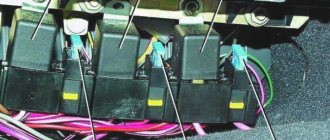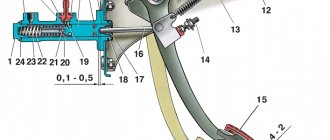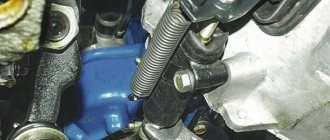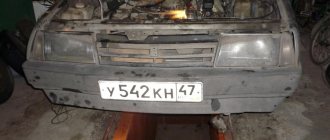Clutch VAZ 2106
On modern cars, the clutch may have a design slightly different from older cars, but the essence of the application of this mechanism remains the same. Like any other vehicle component, the clutch consists of a number of parts that wear out and become unusable over time. Therefore, it is worthwhile to dwell in more detail on identifying the causes and eliminating malfunctions of the VAZ 2106 clutch.
What is the clutch used for?
Equipping a car with a clutch is necessary to separate the gearbox and power plant, their smooth connection at the start of movement, as well as when changing gears. The mechanism is located between the gearbox and the engine, with part of the clutch elements fixed on the engine flywheel, and the other part in the clutch housing.
What does it consist of?
The main structural elements of the node in question are:
- master cylinder;
- working cylinder;
- basket;
- driven disk;
- release bearing;
- fork.
VAZ 2106 clutch device: 1 - adjusting nut; 2 - lock nut; 3 — tension spring; 4 — piston of the clutch working cylinder; 5 - working cylinder; 6 — bleeder fitting; 7 - flywheel; 8 — hydraulic clutch pipeline; 9 - crankshaft; 10 — master cylinder reservoir; 11 — piston of the main cylinder; 12 — pusher piston; 13 - main cylinder; 14 — pusher; 15 — servo spring of the clutch pedal; 16 — clutch pedal release spring; 17 — clutch pedal travel limit screw; 18 — clutch pedal; 19 — pressure disk; 20 — driven disk; 21 — clutch casing; 22 — pressure spring; 23 — clutch release bearing (release bearing) VAZ 2106; 24 — gearbox input shaft; 25 — ball support for clutch release fork; 26 — clutch release fork; 27 — clutch release fork pusher
Master cylinder
The clutch master cylinder (MCC) ensures effective transmission of force from the pedal to the clutch fork through brake fluid and the working cylinder, interacting through the release bearing with the spring elements of the basket. The main circulation pump is located under the hood near the expansion tank and communicates with the working cylinder using a hose. The unit in question consists of a housing, two cylinders with seals and a spring.
The hydraulic clutch transmits force from the clutch pedal to the fork through the brake fluid and the working cylinder
Working cylinder
The function of the clutch slave cylinder (CLC), although simple, is important - to receive the force transmitted from the master cylinder for subsequent movement of the clutch release fork. On the VAZ 2106 the RCS is installed on the clutch housing. Structurally, it is similar to the working cylinder, but has one piston.
The clutch slave cylinder receives force from the main clutch for subsequent movement of the fork
Basket
By means of a pressure disk (basket), the interaction of the driven disk with the flywheel is ensured. If problems occur with the shopping cart, the system stops working. The pressure plate (PD) is pressed against the driven one by means of special springs, which, at the moment the clutch is disengaged, act as return springs, i.e., they press out the PD. This method of operation ensures smooth gear shifting, which increases the service life of gearbox elements.
The basket is made of a diaphragm spring, a pressure disk and a casing. The spring presses on the LP and creates a compression force, transmitting rotation. The spring structure with its outer part acts on the edges of the pressure plate. The inner diameter of the spring is made in the form of petals, onto which the release bearing presses.
Through the basket, the driven disk interacts with the engine flywheel
Driven disk
The driven disk provides a soft connection of the box to the motor. It is located between the basket and the flywheel of the power plant. To ensure that the clutch engages without jerking, the disc design includes springs that help dampen vibrations. Both sides of the disc are equipped with linings made of friction material that can withstand high temperatures.
The driven disk allows for a soft connection of the gearbox to the power unit
Release
The purpose of the release bearing is to separate the basket from the driven disk by pressing the LP petals. The bearing is installed in the clutch housing and moves through the clutch fork.
The release bearing acts on the petals of the basket to separate it from the driven disk
Clutch problems
The VAZ 2106 clutch, although rare, still causes problems for the owners of this car. Malfunctions can be of various types and they also manifest themselves in different ways. Let's take a closer look at them.
Brake fluid leak
The working medium of the “six” clutch mechanism is brake fluid, which sometimes leads to some problems:
- Fluid leakage due to damage to the hose between the master and slave cylinders. The connecting element may become unusable when installing a low-quality product or as a result of rubber aging. To eliminate the problem, the hose will need to be replaced;
Liquid leakage is possible if the hose connecting the GCS and RCS is damaged - depressurization of the main circulation system. The tightness in the cylinder is ensured by lip seals, which wear out and become rough over time, as a result of which they begin to leak liquid. The way out of the situation is to replace the cuffs and then bleed the system.
Drives the clutch
The concept of “clutch drive” is used when the mechanism is not completely disengaged. This can happen for several reasons:
- The driven disk was damaged, causing axial runout. The most correct solution is to replace the part;
- Cracks have formed on the driven disk linings. The appearance of defects is reflected in the inability to engage the clutch in a timely manner. In this case, you should replace the entire disc or the pads themselves;
- The rivets of the friction linings have failed. When the rivets wear out, the fixation of the linings weakens, which leads to problems when the clutch is disengaged and increased wear of the linings themselves;
- Air has entered the hydraulic system. The problem is “treated” by pumping fluid;
- basket distortion. Although the malfunction is rare, if it occurs, you will have to purchase a new pressure plate.
The clutch is slipping
When clutch slip occurs, the mechanism does not engage completely, but this happens for the following reasons:
- oil got on the friction elements of the driven disk. You will have to remove the gearbox and disassemble the clutch mechanism to clean the linings with white spirit;
- The compensation hole in the main circulation system is clogged. To fix the problem, you will need to remove the cylinder, remove the blockage, and then rinse the product in kerosene;
- Friction linings are burnt. The malfunction is eliminated by replacing the driven disk.
Oil getting on the driven disc can cause the clutch to slip and operate jerkily.
Clutch pedal squeaks
The pedal may squeak due to lack of lubrication in the bushings or when the bushings themselves are worn out. To fix the problem, the pedal will need to be removed, the bushings checked for wear, replaced if necessary, and lubricated.
If the clutch pedal bushings are worn or lack lubrication, the pedal may squeak.
Noise when depressing the clutch pedal
On a VAZ 2106, noise when releasing the clutch pedal may appear for the following reasons:
- bearing failure on the gearbox input shaft. The problem appears in the form of a characteristic cracking sound when the clutch pedal is released. In this case, the bearing will have to be replaced;
- release bearing wear. The part fails due to lack of lubricant, which is squeezed out over time. To eliminate the malfunction, the bearing must be replaced.
Noise when pressing the clutch pedal
The clutch may also make noise when you press the pedal. The reasons may be as follows:
- loss of rigidity or breakage of the springs of the driven disk. This leads to vibrations that cannot be extinguished in a timely manner. The solution to the problem is to replace the driven disk;
A broken spring in the driven disc may cause noise when the clutch pedal is pressed. - Damage to the release bearing or basket.
If, when noise occurs, the problem is not resolved within a short time, then the broken part may damage other elements of the mechanism.
The pedal falls
There are cases when on a VAZ “six”, after pressing the clutch pedal, it does not return to its initial position. There are few reasons for this phenomenon:
- air entering the hydraulic drive system. In this case, the pedal “falls” after several presses, so the system will have to be pumped;
- the spring responsible for the pedal return fell asleep. It is necessary to check the spring and, if necessary, replace it.
Video: clutch problems and solutions
Basket installation
To repair or replace the clutch basket, you need to unscrew the bolts holding it. If you can see that the basket petals are very worn, it is best to replace the entire part.
To install a new basket, it is necessary to straighten or center the gearbox input shaft, since otherwise the displacement of the disk will not allow the box to be put on. Therefore, the operation of inserting the disk with the mandrel into the flywheel must be performed very carefully.
After putting the basket in place, you need to tighten the clutch bolts. In this case, the bolts are tightened gradually, over 3 or 4 turns of the flywheel.
The final step in replacing the basket is to install the release bearing on a well-lubricated shaft.
The specific technology for removing the clutch basket and replacing it depends on the type of engine and type of clutch mechanism, but for most cars it is similar to that described above.
Installation of all dismantled parts and their adjustment is carried out in the reverse order.
Provided that all operations are carried out in a strictly specified sequence and in compliance with technical regulations, repair and replacement of the basket or other parts of the clutch mechanism is possible with your own hands in your own garage.
Will you be upset or not when you find out that the manufacturer does not indicate specific figures for clutch life
. If, for example, in the brake system, it is clearly stated that the thickness of the brake disc should be such and such, then why is this not applicable to the clutch?
The fact is that clutch wear depends on many reasons.
, and first of all, of course, on how the driver changes gears and in what mode he uses the clutch.
And while clutch disc thickness cannot be measured the same way brake disc thickness can be measured with a caliper, there are ways to measure it. There are two of them. The first way
to measure the thickness of the clutch disc is with a special measuring gauge.
This method does not require dismantling the clutch; it is performed on a lift. But you are unlikely to use it. The second method
is simpler to implement and allows you to determine the wear of the clutch disc in order to replace it.
Replacing the driven disk is a procedure provided by the manufacturer, because The driven disk is a consumable part. The check is carried out as follows: with the engine running, you need to put it in high gear, accelerate it, and if the car does not stall, this means that the driven disk is worn out and requires replacement
.
It must be remembered that such a check of the thickness of the clutch disc is not technologically correct, but it is effective and allows you to determine the condition of the disc extremely accurately. As already mentioned, the life of any clutch is determined by its operating conditions. Without going into technical details of the interaction of clutch parts, you should understand that basically the life of the clutch and the wear rate of the discs depend only on the driver. A clutch of the same quality and manufacturer can last 5,000 km for one driver, and 100,000 for another. Participation in drag racing, frequent slipping, abrupt starting at high speeds, ingress of foreign liquids and objects, unqualified installation and adjustment clutch - all this reduces the life of the clutch. How to check the clutch?
The clutch is checked using already proven and reliable folk methods, and only by them. Naturally, in addition to disassembling the clutch. We are talking about how you can check the clutch of your car yourself, and then decide whether you need a more in-depth diagnostic with dismantling the clutch mechanism.

